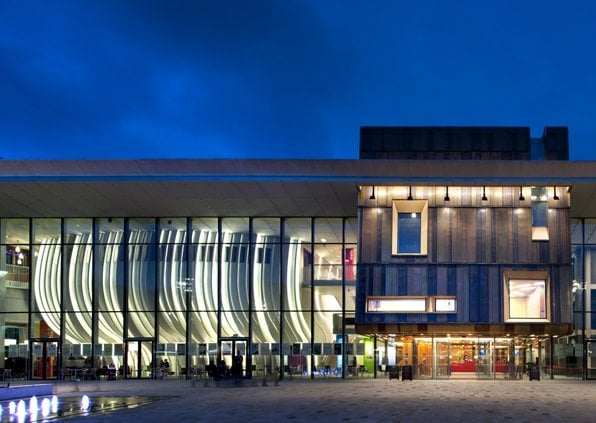
Doncaster's Cast with its glazed exterior to draw people in
Busy buildings
Barry Pritchard says that new arts buildings must be inclusive, exciting and adaptable if they are to widen engagement and genuinely regenerate a town or city centre.
Tradition has been a principal influence on theatre design and throughout history architects sought to maintain its exclusiveness and prominence within a town or city centre. However, with increased competition for footfall, architects who specialise in arts buildings are now designing with inclusivity in mind, understanding that for today’s performance venues, commerciality and engagement is equally as important as any aesthetic appeal.
Many of today’s arts and performance venues face economic and social challenges. Industrial decline, aspirations for home ownership and suburban living have caused a fall in the number of visitors to some of our town centre venues. High-tech home entertainment is an additional challenge. For many people theatre and live performance seem alien and the deep-rooted perception (again for many) that the arts is middle-class entertainment makes the task to attract wider audiences more difficult. However, the impact of an ‘artless’ town reverberates widely through a community which may enjoy a thriving daytime economy but quickly becomes an insular night-time environment, one that is focussed on a culture of drinking.
Architects need to look beyond the auditorium and production to what the community needs
The lavish refurbishment of the Watford Colosseum transformed the night-time perception of the town centre and the fortunes of surrounding businesses by generating footfall and providing the area with new and engaging live entertainment. Having undergone refurbishment, the venue now offers a wider range of events including live comedy and pop music, with the understanding that today’s arts spaces have to diversify if they want to attract an audience above and beyond traditional art and theatre lovers. The refurbishment was not limited to simply satisfy an evening audience but included spaces for meeting, eating and participating in various cultural activities throughout the day. Before its renovation, it opened its doors at 7pm to cater for a theatre-going crowd but now shoppers, visitors and students from the nearby technical college use the space as a social hub, taking advantage of its long opening hours that run from early morning until midnight. It is fast becoming the new heart of the town.
Since it opened in September 2013, Doncaster’s Cast has attracted more than 100,000 visitors in what has been described as one of the UK’s cities least engaged in the arts. When designing Cast, we aimed to create a venue that would suit a wide range of performers – from drama, comedy and musical theatre to live music gigs and smaller-scale experimental theatre – as well as host a variety of community and education projects. The glazed exterior creates a link between the town’s public space and its new cultural heart. From the square visitors can see people moving around in the foyers, café spaces and education suite throughout the day and well into the evening. These spaces form 50% of the building and have not only become a social hub but also a way of introducing a performing arts environment to a new audience.
While momentum for providing spaces for arts as part of ongoing regeneration continues, funding is not as readily available as it was in the heyday of the Lottery and local authorities are having to explore new avenues for investment. These new partnerships, where provision is made for the arts as part of a developer’s plans, are increasingly recognised as an avenue for funding. Milton Court, the new facility for London’s Guildhall School of Music & Drama, was designed initially on behalf of the City of London Corporation. Heron International plc was granted a lease on the land for a major residential development above the school and the City got a £56m turnkey building in return. While the City of London is not in need of regeneration, Milton Court is a leading model for this type of partnership, and there is a role for it as a blueprint for future schemes to ensure the continued growth of our art spaces and bolster successful regeneration.
Architecture alone will not solve accessibility in conceptual terms but it is powerful enough to demystify what happens within its walls and engage those audiences that may be daunted by the arts (or simply more accustomed to other types of entertainment). Architects need to look beyond the auditorium and production to what the community needs and use their expertise to design a space that is exciting, inviting and adaptable, one that has a positive impact on the wider surrounding environment.
Barry Pritchard is Principal Director for RHWL Arts Team.
www.rhwl.com
Join the Discussion
You must be logged in to post a comment.